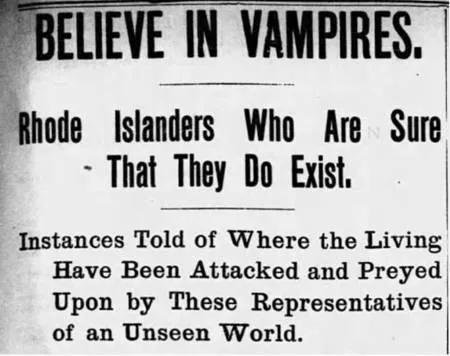Nov 21, 2021
Image: The Boston Globe, 1896 - fishwifeblog.newspapers.com
In the late 1800s, a sense of panic invaded New England according to fishwifeblog.newspapers.com. An alarming number of people were dying of consumption, and residents became convinced that vampire-like creatures were the cause. They believed the vampires were gradually sucking the blood out of innocent victims. To combat the threat, locals sometimes exhumed the bodies of loved ones and ritually burned their organs. They believed this would stop the vampires and prevent the spread of the disease. One of the most famous vampire stories involved Rhode Island resident Mercy Brown.
Consumption (now known as tuberculosis) is spread through bacteria and was one of the leading causes of death at the time. Those infected gradually became sicker and often spread the illness to other family members. Consumption hit the Brown family of Exeter, Rhode Island, especially hard. George Brown was a respected farmer, who along with his wife Mary Eliza, raised seven children. Mary Eliza contracted consumption and died in 1883. The following year, daughter Mary Olive, a 20-year-old dressmaker, also died. In January 1892, daughter Mercy, 19, died, and son Edwin, 24, was sick.
Superstitious neighbors approached George and convinced him that he should exhume the bodies of his wife and daughters. It was, they suggested, the only way to save Edwin. The superstition held that vampires slowly drained the blood from the living and put it into the hearts of the dead. Thus, a buried body with blood in the heart evidenced that vampires were at work. The only way to stop the vampires was to find corpses with blood still in their organs, remove the organs, and ritually burn them.
Hesitant but desperate to save his son, George agreed to the plan. On March 17, 1892, several men from the community went to work digging up the remains of the Browns. Mary Eliza had been dead nine years, and her remains were in an advanced state of decomposition. Mary Olive’s body had also decomposed. But when they disinterred Mercy, they found blood in her heart. She had died two months earlier, and the freezing temperatures had preserved her body.
They removed Mercy’s heart and liver and ritualistically burned them on a stone. The ashes were mixed with a tonic and given to Edwin to drink. The ritual proved ineffective, and Edwin died two months later. By 1899, George lost six of his seven children. Over the next few years, the belief in vampires waned. It took another 40 years until scientists carried out the first clinical trials for the treatment of tuberculosis.
The Boston Globe, 1896 - fishwifeblog.newspapers.com
In the late 1800s, a sense of panic invaded New England according to fishwifeblog.newspapers.com. An alarming number of people were dying of consumption, and residents became convinced that vampire-like creatures were the cause. They believed the vampires were gradually sucking the blood out of innocent victims. To combat the threat, locals sometimes exhumed the bodies of loved ones and ritually burned their organs. They believed this would stop the vampires and prevent the spread of the disease. One of the most famous vampire stories involved Rhode Island resident Mercy Brown.
Consumption (now known as tuberculosis) is spread through bacteria and was one of the leading causes of death at the time. Those infected gradually became sicker and often spread the illness to other family members. Consumption hit the Brown family of Exeter, Rhode Island, especially hard. George Brown was a respected farmer, who along with his wife Mary Eliza, raised seven children. Mary Eliza contracted consumption and died in 1883. The following year, daughter Mary Olive, a 20-year-old dressmaker, also died. In January 1892, daughter Mercy, 19, died, and son Edwin, 24, was sick.
Superstitious neighbors approached George and convinced him that he should exhume the bodies of his wife and daughters. It was, they suggested, the only way to save Edwin. The superstition held that vampires slowly drained the blood from the living and put it into the hearts of the dead. Thus, a buried body with blood in the heart evidenced that vampires were at work. The only way to stop the vampires was to find corpses with blood still in their organs, remove the organs, and ritually burn them.
Hesitant but desperate to save his son, George agreed to the plan. On March 17, 1892, several men from the community went to work digging up the remains of the Browns. Mary Eliza had been dead nine years, and her remains were in an advanced state of decomposition. Mary Olive’s body had also decomposed. But when they disinterred Mercy, they found blood in her heart. She had died two months earlier, and the freezing temperatures had preserved her body.
They removed Mercy’s heart and liver and ritualistically burned them on a stone. The ashes were mixed with a tonic and given to Edwin to drink. The ritual proved ineffective, and Edwin died two months later. By 1899, George lost six of his seven children. Over the next few years, the belief in vampires waned. It took another 40 years until scientists carried out the first clinical trials for the treatment of tuberculosis.
Share this article with friends!
Tags:
#boston#globe,#comsumption,#tuberculousis,#illness,#history,#starzpsychics

